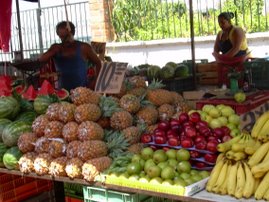The fact that many expatriates are moving to Mexico and other Latin American countries is an interesting phenomenon. Pixie and I attended a lecture last summer by Dr. David Truly who was doing a study on the nature of the retirement migration to the Lake Chapala area. It was an interesting lecture. I recently noticed an article about David and his work written by one of my friends from the Ajijic Writers' Group, Harriet Hart in the online magazine Living at Lake Chapala (http://www.mexico-insights.com/) edited by Judy King. I thought it may be of interest to readers of this blog, so, with permission, I have included it, in its entirety, in this post.
Retirement Migration Study Focuses on Lakeside
Author Harriet Hart and researcher Dr. David Truly discuss his study on retirement migration to Lakeside.
As you moved or prepare to move to Mexico I bet you've never thought of yourself as a migrant or as a representative subject of a doctoral thesis. If you're like me, you prefer to think of yourself as one of a kind, an adventure seeker, the Indiana Joan of your high school graduation class.
Well…think again. There's someone here at lakeside who is studying folks like you and me and the other retirees who left their country of origin to live on the shores of Lake Chapala. Dr. David Truly wants you to be part of his research on retirement migration.
I met David recently and was pleased when he agreed to sit down and let me interview him. Dr. Truly is an associate professor in the Department of Geography at Central Connecticut State University in New Britain, Connecticut. He is also a talented rock guitarist who plays with The Tall Boys at local venues when he's at Lakeside.
David hasn't always been an academic; he was a musician for years, touring the southwest as leader of the Truly Dangerous Swamp Band. He also owned a night club on Hilton Head Island in South Carolina. When a fire damaged his nightclub and a year later his equipment truck caught fire while he was on tour, he knew it was time to reassess his life. "When I finally got off the road I decided to go back to school and fell into geography."
(Left:) When he's not teaching geography in Connecticut, David is the lead singer and guitarist for Lakeside's Tall Boys band. It's hard to tell if David prefers teaching or music. (Right:) The other Tall Boys are Flip Nicholson in the back on bass and Joel Barker.
Several years ago David became specifically interested in North American migration to Mexico. "I always loved Mexico and when my thesis supervisor, Dr. John Winberry, needed someone to accompany him on an exchange to Morelia, I volunteered. I needed a thesis topic and chose 'International Retirement Migration to Lake Chapala'." Dr. Truly got his master's degree in 1996 and his doctorate from the University of South Carolina in 2001.
Since NAFTA, modern franchise convenience stores dot the landscape luring customers away from the traditional madre y padre (mom & pop) stores.
When I asked David what brought him to Chapala, his tale was familiar. Like many of us, he knew someone up north who knew someone down here. He conducted his original research in 1997.
"It's amazing how much things have changed since then." David said. He went on to say he believes the impetus for a lot of that change is NAFTA. "It's transformed the area. Now people have Wal-Mart, Costco, Home Depot, and most of the amenities they're used to back home."
Historically there have been two kinds of foreign settlers around the world. Some had to leave their country, forced away due to political or legal or social reasons—the push factors. They negatively selected to move to another country. Others decided to move based on quality of life and positively selected. Positive selection migrants are motivated by the pull factors of the attractions in another location and perceive an opportunity to improve their lifestyle by relocating.
David saw evidence of both of those groups when he did his first survey in 1997. Both groups had to give up a lot to come to Mexico. Creature comforts that included banking, telephone service, and domestic appliances were hard to come by. Even as recently as 1997 most people didn't have their own washer and dryer! Since NAFTA, retiring migrants can have nearly everything they had back home.
Foreign interest in the Lake Chapala area began in the 1800s. "Originally envisioned as an international tourism resort in the late 1880s by President Porfirio Díaz, the foreign presence in the Lake Chapala Riviera evolved from a small collection of Lakeside cottages that housed writers and artists from America and Europe to its current status as a popular retirement destination."
Dr. Truly divides the evolution of the Chapala Riviera foreign community into four stages:
- Discovery from the 1880s to 1900s
- Founding from the early 1900s to 1950s
- Expansionary from the mid 1950s to mid 1970s
- Established colony from the mid 1970s to mid 1980s.
Dozens of corner stores (one for every 50 houses) used to meet the needs of Lakeside residents, providing everything from wine and beer to bread and eggs.
It was during the founding phase that the character of the foreign community began to be as important a trademark of this area as the good weather. David says the first foreign residents were an eccentric bunch of artists, well-educated travelers and bohemians. They laid the foundation for a tolerant foreign community that created a unique relationship with the native population. Those early days were marked by a "symbiotic host/guest relationship, the tolerant and egalitarian nature of the foreign community and a casual, unstructured lifestyle."
However, the increasing availability of modern goods and services combined with changes in elderly migration patterns and mobility have altered the size and nature of retirement migration to this area. "A new kind of migrant has emerged, one prone to importing a lifestyle rather than adapting to the community's established culture," says David.
The original two types of migrants still come here in retirement, but David says there is now a third category: people who leave home and import their lifestyle here. They come primarily for the climate and lower cost of living and want life here to be as nearly as possible like it was at home.
The implications of this new type of migrant are significant. Whereas the previous two groups had to fit in with Mexican culture, this third wave does not. They can choose to live in gated communities isolating themselves from the Mexican culture and they aren't forced to develop an affinity for that culture. The attitudes and patterns of the people who choose to settle here have a direct impact on the nature of our community.
Researchers Rowles and Watkins have studied the impact of retiree migration on three Appalachian communities. Their findings suggest that as a destination's popularity among retirees increases, the retirement destination passes through five overlapping phases:
- emergence
- recognition
- restructuring
- saturation
- new concerns
This model suggests that as the population of a destination (like Lakeside) increases, local leaders feel obligated to restructure the community to cater to the elderly population's needs. While this may bolster economic growth, it can also create new problems such as overcrowding, increasing traffic density, environmental degradation and socio-political conflict. This resembles what happens to tourist resorts that go through another life cycle: exploration, involvement, development, consolidation and stagnation.
New housing developments are changing the face of the Lakeside community.
A retirement community or tourist destination undergoes development until the destination exceeds its carrying capacity and begins to show signs of stagnation. Then it declines in popularity. "Significantly," says David, "not only will the size of the migrant community affect the nature of the area, but the psychological and/or social profile of those immigrants will also become a determining factor in the destination's development." This is why it is so important to know who comes here, why they decided to come and whether or not they choose to stay.
David personally interviewed 40 households/individuals for his first study and also distributed 1650 surveys. The interviews addressed four areas: demographics (educational background, income, age and marital status), factors related to the migration decision-push or pull, the migrant's expectations of the area and level of satisfaction, and finally current impressions.
His subjects in that first study fell into three clusters: 106 negatively selected to relocate to Mexico, 77 positively selected Mexico and 68 were the new type of migrants. The traditional migrants were more satisfied with life in the area and felt it had lived up to their expectations. The new migrants were less satisfied and demonstrated less tolerance for the native Mexican culture, particularly regarding business dealings.
"The most striking characteristic of the new group was their lack of economic and social participation within the local community. In contrast, the positively and negatively selected (traditional) groups were more active in local charities, had more Mexican friends than the new migrants, and supported local businesses as opposed to the new migrants who were particularly fond of the multi-national franchises (e.g. Wal-Mart). The traditional groups also exhibited less concern over the common frustrations associated with day-to-day life in Mexico."
Gated communities have become the preferred housing option for the third wave of retirees moving to lakeside.
David is interested in why people retire to Mexico in the first place but he also wants to know who stays and who goes back to their country of origin. "Conventional wisdom around here says that seven years is the turning point," I told him. "After that you either stay or leave." David agreed.
As far back as 1977 studies showed that 65% of newcomers stayed six years or less and 25% stayed six years or longer. One of the reasons was if people retired at 65, six years later they may experience health concerns that prompt them to leave. This may shift. People are retiring younger; their health may be better and there are significant differences when they get here such as internet contact with family back home, cheap air fares, etc.
"Can you predict who will stay and who will leave?" I asked.
"You can. At first I thought the predictor would be income level but it wasn't. There are three important factors that have nothing to do with finances. They are: education level, prior mobility and international travel experience. Educated individuals who have a history of international travel are more likely to be happy here.
David wanted to know why my husband and I recently decided to become full-time residents of Lakeside after six years as snowbirds. He asked us for some basic background information and when he discovered we are both university graduates who had traveled extensively prior to retirement he laughed and said, "See, you fit the profile."
David adds that there are two important questions to ask yourself to help determine whether or not you'll be happy at Lakeside:
1) How dissatisfied are you with your country of origin?
2) How much do you appreciate Mexican culture?
Migrants who socialize with the local Mexican people are happier than those who remain isolated from them.
There are other retirement destinations in Mexico that are much more "Americanized"-places such as Cancun or San Miguel de Allende-and there are others that are much more traditionally Mexican. Chiapas is a good example. Lakeside is unique.
"Long time residents say Lakeside has changed…and not for the better. We've got 7-11 stores, traffic lights, and many more expatriates than in days gone by." I said.
Dr. Truly shares their concerns. "This is a special place. It's crucial to understand the social dynamics. Once you damage the integrity of the socio/economic balance, there's no turning back. That's why I'm doing a follow up study."
"By 2011 the first wave of baby boomers will hit age 65," said David. "What are they going to do and where are they going to go?" Those are important questions. Will there be a wave of new migrants? "Well, bear in mind most retirees don't move to a foreign country. Over the next few years, 20% may do so but they won't all head to Mexico."
Still, Dr. Truly is concerned. "I'm trying to impress upon folks the importance of their actions. The real estate companies are paving the way for the future. Look what happened to Santa Fe, New Mexico. We all know of tourist destinations that have been changed forever. We don't want that to happen here."
Migration drives up prices and negatively impacts the ability of the local residents to own property. Prices of everything rise in a tourist or retirement community. Dr. Truly thinks Ajijic may have reached its saturation point. People are looking to Chapala and Jocotepec-the new bastions. "You can still get a nice home in those communities for $100,000." People may also start using Lakeside as a jumping off point. There are plenty of other places that people can still take advantage of such as Patzcuaro, Morelia, and Guanajuato.
The Tall Boys recently released their first CD. You can hear cuts from "Blonde Babes and Boot Leg Beer" at www.tallboysmusic.com.
David says that it's important to realize that certain types of expatriates made this place work for them in the past. "The old timers are aware of the deep-seated social issues, the role of el patron in the lives of the employees." David predicts that there will also be another new group of migrants to Lakeside - "nationalized Mexicans who have been working North of the border and wish to return in retirement." The social dynamics have changed and will continue to do so, but "it's important not to damage the balance that has worked here for decades and which has made Lakeside so unique."
For the past 100 years the communities along Lake Chapala have managed to remain a unique and popular destination for a few thousand foreigners. While the natural beauty and lower cost of living continue to be important incentives for migration, David Truly believes the community's unique culture and charm have proven to be essential to the area's popularity. This leads to a dilemma. If the attraction of the area is dependent on the individuals who migrated here, what will happen once they are gone, replaced by different migrants with different values—that third wave?
David is currently conducting follow up research to his 2007 doctoral thesis. He encourages readers to visit his website http://www.totacc.com/user/esautter/guadtrial.htm and fill out the survey. What he would like to do next is write a book about the area. "Living here for a year with my family allowed me to observe the habits of the expatriates who have chosen to make this their home. I would like to write about the role of the churches and charitable organizations in the expatriate community."
"I'm like most other residents. Lakeside has had a powerful effect on me. This is a true global village. We all have a role to play in keeping it that way."
Stay in touch with the Tall Boys at www.tallboysmusic.com, and find out where they'll be playing next. Be sure to register to be on the mailing list of announcements of upcoming Lakeside appearances.



































































2 comments:
Hello. This post is likeable, and your blog is very interesting, congratulations :-). I will add in my blogroll =). If possible gives a last there on my blog, it is about the Plotter, I hope you enjoy. The address is http://plotter-brasil.blogspot.com. A hug.
Hello. This post is likeable, and your blog is very interesting, congratulations :-). I will add in my blogroll =). If possible gives a last there on my blog, it is about the GPS, I hope you enjoy. The address is http://gps-brasil.blogspot.com. A hug.
Post a Comment